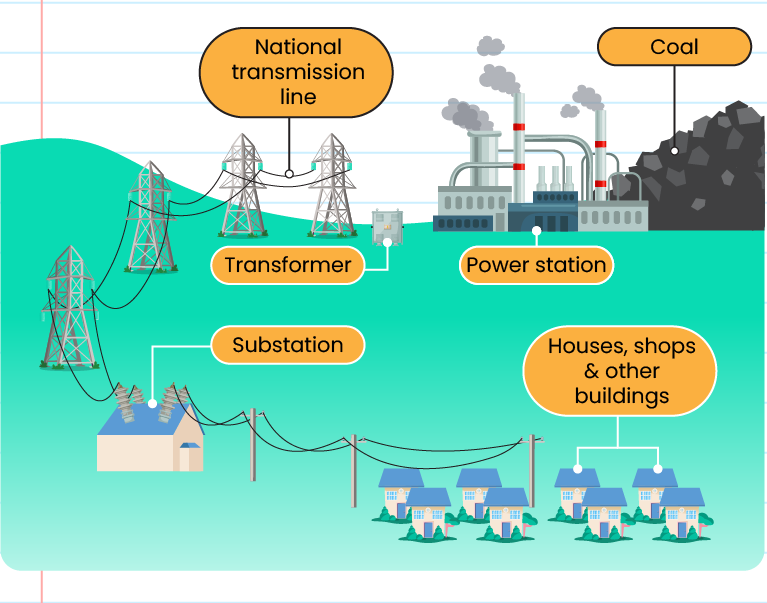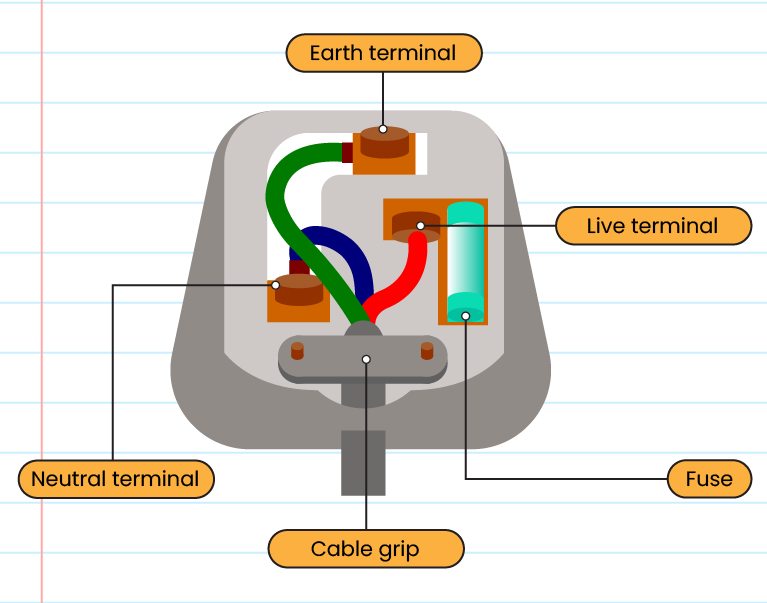| 6.3 |
Transmission and Distribution of Electricity |
Structure of electricity distribution system:


-
The electricity distribution system consists of a National Grid network, transformer stations, switching fields, main inlet substations, and division substations
-
Power generating stations, alternating current with a voltage of about 11 kV (11,000 V) are produced
-
The alternating current voltage is raised to 132 kV (132,000 V) by a step-up transformer and enters the National Grid Network
-
The National Grid Network has one cable network connected to all power stations
-
The current voltage in the National Grid Network needs to be high to increase the distribution efficiency by reducing the loss of electrical energy in the form of heat
-
The National Grid is connected to the main inlet substation where the current-voltage is lowered by a step-down transformer to 33 kV (33,000 V)
-
The 33 kV voltage is further lowered to 11 kV (11,000 V), 415 V, and 240 V at the section substation by a step-down transformer
-
Switch fields are placed at several places along the cable to disconnect the circuit automatically in the event of a short circuit
- The advantage of the National Grid Network is that the generation and distribution of electricity can be controlled according to demand and energy loss can be reduced because electricity is distributed at high voltage
- Cables carrying electricity supply in the National Grid Network can generate magnetic fields around them and can cause interference to electrical equipment close to the National Grid Network pylons
The home wiring system:
-
There are two types of wiring that are commonly used, namely single phase wiring and three-phase wiring
-
Single-phase wiring for homes (240 V) and three-phase wiring for light and heavy industry (415 V)
-
Electricity from the substation is sent to the house through two types of wire, namely live wire (brown color) and the neutral wire (blue color).
-
The live wire carries the electric current to the house while the neutral wire returns the electric current to the section substation
-
Current is distributed to the house through the main fuse box and into an electric meter that records the number of units of energy used
-
The main fuse serves to disconnect the circuit if there is an excess current
-
Each part of the circuit in the house is fitted with its own switches and fuses
3-pin plug structure:


|
Section
|
Function
|
|
Live wire (L)
|
Carries current from part substations to electrical equipment
|
|
Neutral wire (N)
|
Returns current from electrical equipment back to the section substation
|
|
Earth wire (E)
|
Conducts leaking current from electrical equipment to earth
|
|
Fuse
|
The wire in it will melt and cut off the current supply in the event of a circuit break
|
2-pin plug:
Safety components in-home wiring systems:
|
Components
|
Function
|
|
Switch
|
Complete or disconnect the current flowing in an electrical circuit
|
|
Earth wire
|
Conducts leaking electric current directly to earth and prevents the occurrence of electric shock
|
|
Fuse
|
Disconnect the circuit when the current flowing exceeds the maximum value of the fuse and ensure electrical equipment is not damaged
|
|
Circuit Breaker
Leak to Earth
(ELCB)
|
Disconnect the electrical circuit when a large current is flowing, for example during a thunderstorm
|
|
Miniature Circuit Breaker (MCB)
|
Controls the value of current flowing to various parts of the circuit in the house
|
|
Lightning conductor
|
Installed on tall buildings to prevent the building from suffering damage due to being struck by lightning
|
Fuse:
-
A fuse is a high-resistance fine wire made of tin and lead alloy that has a low melting point
-
There are two types of fuses, wire fuses, and cartridge fuses
Short circuit:
-
Occurs when an electric current flows through a path with the lowest resistance
-
Short circuits in electrical equipment occur due to torn or rotten wire insulation
-
Short circuit phenomena can cause electric shock, circuit damage, fire, and explosion
-
The causes of electrical accidents are the negligence and indifference of the users themselves
-
Examples include misuse of wiring systems and non-compliance with safety measures
Safety measures to prevent electrical accidents:
-
Ensure the installation of electrical circuits in the house in accordance with the rules
-
Do not connect too many electrical appliances in the same circuit
-
Do not touch the exposed wire
Steps to be taken during an electric shock:
-
Do not touch a victim who has been electrocuted as you are also likely to be electrocuted
-
Turn off the main switch immediately
-
Give first aid if the victim is not breathing and seek medical attention immediately